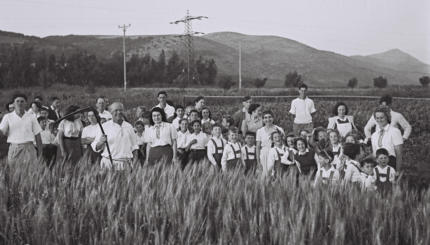At first glance, this part of the festival cycle seems out of step with the cycle of our personal lives. For most of us, summer is a time of ease and enjoyment of the outdoors. The natural cycle is marked by the continued growth of spring plantings. But our history, with its mythic dimensions, forcefully reminds us that there can be another kind of summer, one whose heat is a consuming furnace rather than beneficent warmth.
Anyone who has spent a summer in Israel can more easily understand how the Three Weeks is in fact in consonance with the natural cycle. There the afternoon sun seems to bleach all the color from the landscape. Movement slows or comes to a halt in the afternoon—for even if the sun is no hotter than in the United States, it seems to beat down unrelentingly on the land’s inhabitants.
One can easily become parched and debilitated just from spending a few hours outdoors. No longer are the prevalent colors the greens of spring that decorated the synagogue on Shavuot; rather, the colors are a blazing white of sun on stone and the contrasting deep blacks of shade. Thus in Israel it is easy to call up images of a burning temple and a desolate land.
The 17th of Tammuz & the Golden Calf
This aura of desolation reflects the fall from the heady moments of Egypt and Sinai. No sooner is the unique experience of the revelation at Sinai over [on the holiday of Shavuot] than Moses and God disappear for 40 days. Feeling lost, the people turn to a golden calf (on the 17th of Tammuz). [The sin of the golden calf is ascribed by tradition, if not historical scholars, to the 17th of Tammuz.]
With your help, My Jewish Learning can provide endless opportunities for learning, connection and discovery.
The air is filled with a sense of loss and abandonment: the people abandoned by God, God abandoned by His people, each longing for the other, each eager to renew the covenant of Shavuot, the trust of that night of the Exodus when we faithfully went off into the desert with only God to sustain us. No rain, no sustenance, no wave offerings, no joy. Illusions or ideals seem to have melted under the fiery rays, of the summer sun with no sheltering wings to protect us.
Tisha B’Av [the ninth of Av] erases the last innocence and brings home the difficulty of living by the covenant, for the covenant means being chosen for strife, anger, and even destruction and persecution, as well as love. No longer a mountain suspended over our heads (as at Sinai), nor as yet a sukkah of our own construction, we cringe in the heat of the day, and even find solace in the blackness of three long weeks of night and nightmare. We sit as mourners on Tisha B’Av, first remembering and then bewailing what could have been.
Heading Toward Yom Kippur
The two worst sins of the desert are attributed by tradition to these two days respectively: the golden-calf incident on the 17th of Tammuz and the incident of the spies [who reported that the Land of Canaan was unconquerable] on Tisha B’Av. The first incident, only 40 days after the Revelation at Sinai, shows how quickly the people forgot the Sinai experience in seeking a tangible image to worship. The second incident occurred in the second year of the Exodus. Because they believed the spies’ report that they could not defeat the inhabitants of Canaan, God condemned that whole generation to die in the desert; only their children would enter the Promised Land. These rejections of God and of Eretz Yisrael can be regarded as prophetic of the later historical experience when the Jewish people were exiled from both God and the land.
The rest of Jewish history is an attempt to work our way back. According to tradition, the Israelites received final forgiveness for the golden-calf incident when Moses came down from Mount Sinai at the end of the third period of 40 days. That day was the 10th of Tishrei—Yom Kippur.
Just as Yom Kippur brings forgiveness for the golden-calf incident of the 17th of Tammuz, so the minor holiday Tu B’Av [the fifteenth of Av](according to one tradition) brings forgiveness for the spies’ incident of Tisha B’Av. It marks, in fact, the end of the 40 years of wandering [with the death of the generation that had left Egypt] and immediately precedes the entrance to the promised land. No longer abandoned in the desert, we, as part of the mythic dimension of Judaism, can end our aimless wandering and finally move onward.
Rediscovering Joy After Tisha B’Av
Tu B’Av provides a contrast of joyous celebration following the ever-deepening gloom and mourning of the Three Weeks. Coming seven days after Tisha B’Av, Tu B’Av symbolically serves as the end of the shiva—the seven days of mourning for the dead. Just as the mourner ends shiva on the morning of the seventh day, so may we cast off the blackness of despair and go out of our house of mourning wearing white and dancing and courting in the fields as did the maidens of old in Israel.
From Tu B’Av we are ready to move on to Elul, a prelude to the High Holiday season with its themes of renewal and return. In fact, the period of Elul embodies a process of courtship between us and God. This theme of courtship is captured in the traditional belief that the Hebrew letters of the word Elul are an abbreviation for the phrase Ani le-dodi ve-dodi li—”Iam my beloved’s, and my beloved is mine,” referring to God and Israel. Estranged from each other during the Three Weeks, Israel and God rediscover each other beginning with Tu B’Av and initiate the slow and at times painful process of becoming lovers again. This process climaxes with Yom Kippur, when we are forgiven for that original breach of faith, the incident of the golden calf, which began this whole process of mourning and renewing on the 17th of Tammuz.
Reprinted with permission from The Jewish Holidays: A Guide and Commentary (HarperCollins Publishers Inc.).
Elul
Pronounced: eh-LULE, Origin: Hebrew, Jewish month usually coinciding with August-September.
shiva
Pronounced: SHI-vuh (short i), Origin: Hebrew, seven days of mourning after a funeral, when the mourner stays at home and observes various rituals.
Tammuz
Pronounced: tah-MOOZ (oo as in boot), Origin: Hebrew, Jewish month that usually coincides with June or July.
Yom Kippur
Pronounced: yohm KIPP-er, also yohm kee-PORE, Origin: Hebrew, The Day of Atonement, the holiest day on the Jewish calendar and, with Rosh Hashanah, one of the High Holidays.


